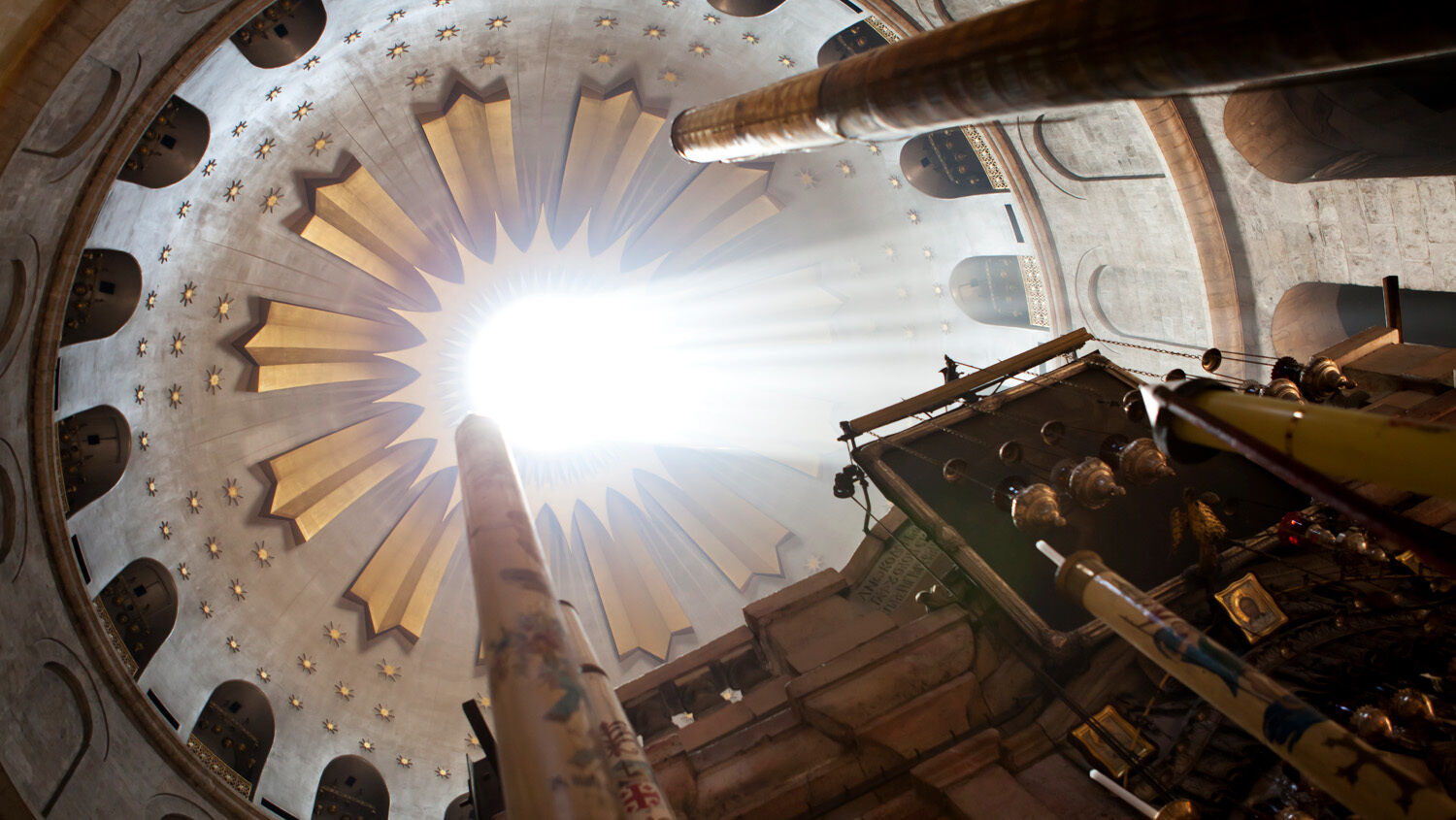
Playing With Fake Fire
Jerusalem’s Church of the Holy Sepulchre is built around the Aedicule, a structure many believe was the tomb of Jesus. According to legend, every year on the day before Easter, a beam of light shines into the Aedicule. This beam sparks a miraculous flame called the “holy fire.” The Eastern Orthodox Church claims itself the custodian of this tradition. Every year, the Orthodox patriarch of Jerusalem enters the Aedicule to collect the fire and share it with pilgrims waiting outside. As proof of the miracle, before the patriarch enters the Aedicule, attendants search him in public to show he carries no lighting device. This tradition has been going on for well over a millennium.
But if believers wanted a modern-day miracle to build their faith on, there is one big problem: The miracle is fake.
Greek investigative journalist Dimitris Alikakos published a book titled Redemption—The Case of the Holy Fire in 2019. In it, he claims the holy fire springs up not from a miraculous beam of light but from a man with a lighter. Some of his journalistic methods were deceptive. But among other testimonies, he obtained a video of Archbishop Isidoros, custodian and abbot of the Holy Sepulchre, stating how the candle gets lit. Alikakos asked Isidoros: “You go in, light [the fire] over the Holy Sepulchre, and leave [it] to be found lit by the patriarch. Is it so or not?” The answer? “So it is.” Later in the interview, Isidoros admitted, “It’s not a miracle.”
The Patriarchate of Jerusalem took Alikakos to court on March 20. According to Balkan Insight, the lawsuit claims that “as a result of the book’s publication, many Orthodox believers have increasingly doubted their priests.”
“The plaintiffs have tried to hide the truth,” Alikakos told media. “I feel great joy and satisfaction that their video testimonies were heard in court today, where they confess that the holy fire lights up naturally” as opposed to supernaturally.
I’m not bashing any individual faith, but an interesting question pops into mind: Why is the Western world traditionally Christian? Why does most of the West see the Bible as their founding spiritual document? It is because of the Orthodox, Catholic, Anglican and other “establishment” churches.
These churches in many respects built Western civilization. They’ve been the moral standard looked to since ancient Roman times. Like the Bible itself, they claim to be the timeless, authoritative representatives of the infallible God. People look to the Bible as an authority only because those same churches have claimed it as an authority for centuries.
Then, one of these institutions exposes itself as lying for over a thousand years. Its tradition of miracles is a fraud.
Can anybody blame congregants for “increasingly doubting their priests”? But if this is the case, what about religion as a whole? If the miracle of the holy fire is a fake, what about Noah’s Flood or the parting of the Red Sea or Jesus walking on water?
If churches fake their divinity, where does that leave the Bible? If you can’t believe the churches, can you believe the Bible they claim to preach from? Why believe the Bible if the only reason to do so is because of a church that lies?
Of course, the Bible nowhere says that a special beam of light would come annually and start a miracle fire. The holy fire, like many a medieval myth, is a superstitious tradition of men. “[I]n vain do they worship me,” Jesus said, “teaching for doctrines the commandments of men” (Mark 7:7). Acts 5:38 states that if “[a] work be of men,” even if it has a religious facade, “it will come to nought.”
Supposed miracles like the “holy fire” are a work of men. Men fail. Men lie. And even if packaged in a Christian-sounding veneer, Jesus brands this kind of worship as “vain.”
But what about the Bible itself?
“Have you ever proved whether, as the Book itself purports, it is the authoritative Word of the Creator God?” late theologian Herbert W. Armstrong asked in The Proof of the Bible. “Rather, have you not simply assumed, from what you have heard, read or been taught, that it is either authentic, or else the religious writing of a small ancient Jewish race, groping in the darkness of human ignorance and of superstition, trying to develop a concept of God?”
Unlike the cryptic ceremony surrounding the holy fire, the Bible has nothing to hide regarding its authenticity. The Apostle Paul commanded in 1 Thessalonians 5:21, “Prove all things ….” Thayer’s Greek Lexicon translates the word “prove” as “to test, examine, prove, scrutinize,” and “to recognize as genuine.” God thunders in Malachi 3:10 to “prove me now.”
“Isn’t it about time—and the point of rational wisdom—that you prove this important question once and for all?” Mr. Armstrong wrote. “Because, if the Bible is in fact the inspired, authentic Word of a living, all-knowing, all-powerful God, then your eternity will be judged by it” (ibid).
If the Bible tells the reader to prove its authenticity, that implies the Bible is provable. There is no time machine to send people back to see the Exodus or the crucifixion for themselves. But if one is willing to invest time in study with an open mind, the proof of the Bible exists. This proof relates to the Bible’s accounts of miracles—miracles far more provable than any hidden fire. But it’s up to the individual to accept it.
To learn more about what kind of proof exists for the Bible and how it is relevant for today, request a free copy of The Proof of the Bible.
